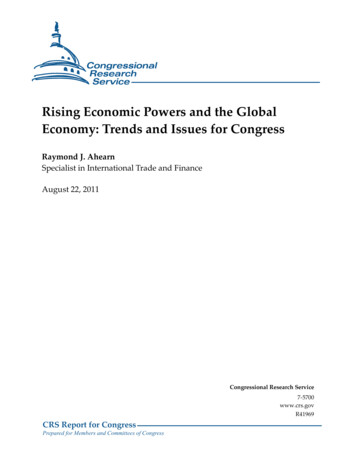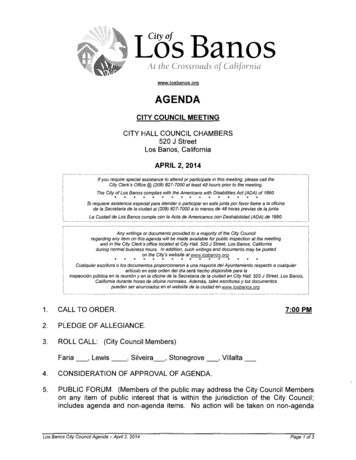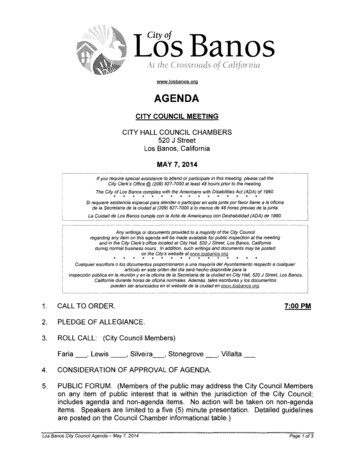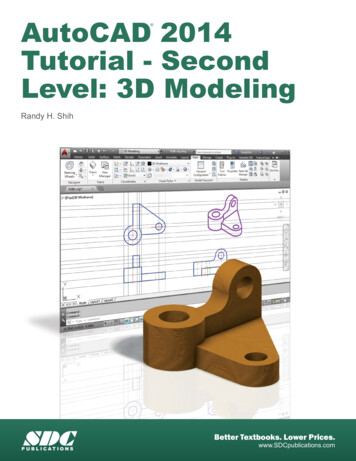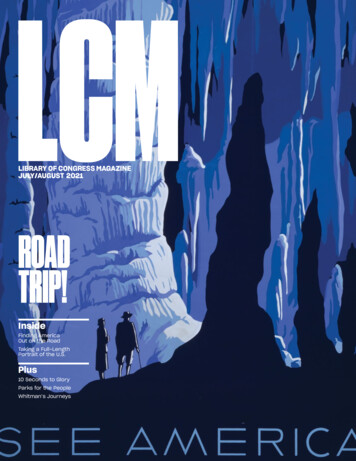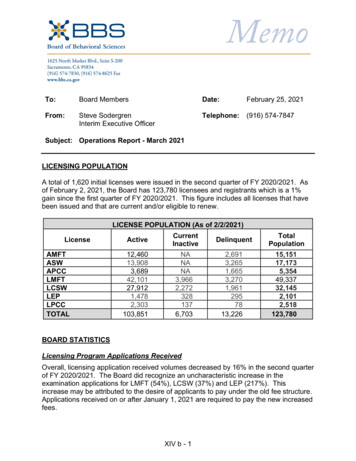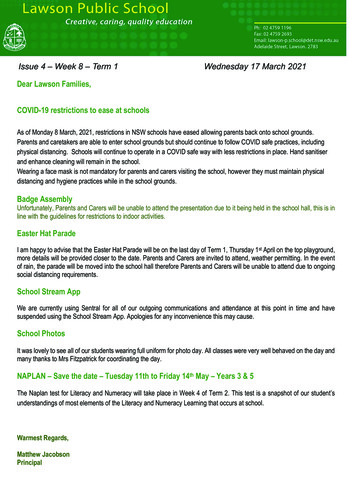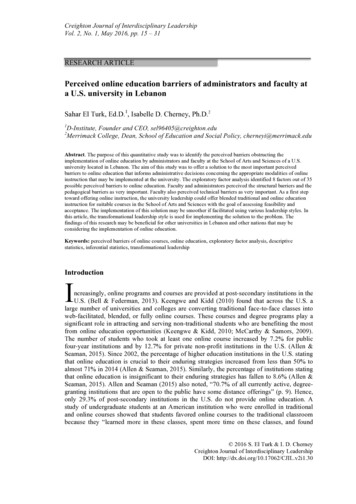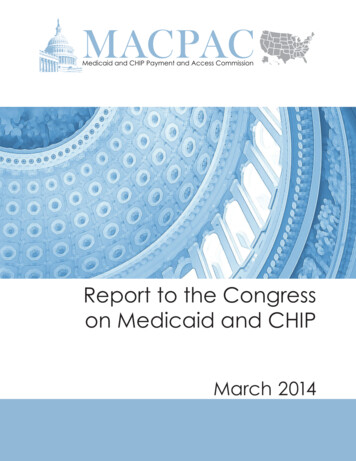
Transcription
Report to the Congresson Medicaid and CHIPMarch 2014
The Medicaid and CHIP Payment and Access Commission (MACPAC) is anonpartisan Congressional advisory commission that provides analytic supportand makes policy recommendations to the Congress, the Secretary of the U.S.Department of Health and Human Services, and the states on a wide range ofissues in Medicaid and the State Children’s Health Insurance Program (CHIP).These include:feligibility and enrollment,faccess to care,fpayment policies,fbenefits and coverage policies,fquality of care, andfthe interaction of Medicaid and CHIP with Medicare and the health caresystem, andfdata to support policy analysis and program accountability.MACPAC is statutorily required to submit two reports to the Congress byMarch 15 and June 15 of each year. The reports include MACPAC’s policyrecommendations and also provide the Congress and the public with abetter understanding of the Medicaid and CHIP programs, their roles in U.S.health care, and the key policy and data issues outlined in the Commission’sstatutory charge.Each of MACPAC’s 17 Commissioners, appointed by the U.S. GovernmentAccountability Office, votes on the recommendations contained in the reports.The Commissioners hail from different regions across the United States and thereports reflect the diverse perspectives they bring to policy deliberations frombackgrounds in medicine, nursing, public health, and managed care, as parentsand caregivers of Medicaid enrollees, and Medicaid and CHIP administration atthe state and federal levels.
Report to the Congresson Medicaid and CHIPMarch 2014
March 14, 2014The Honorable Joseph R. Biden, Jr.President of the SenateU.S. CapitolWashington, DC 20510The Honorable John A. BoehnerSpeaker of the HouseU.S. House of RepresentativesU.S. CapitolH-232Washington, DC 20515Dear Mr. Vice President and Mr. Speaker:On behalf of the Medicaid and CHIP Payment and Access Commission (MACPAC),I am pleased to submit MACPAC’s March 2014 Report to the Congress in accordance withthe statutory requirement that we submit an annual report to the Congress no later thanMarch 15. As in prior years, our work focuses on the important and longstanding role ofMedicaid and the State Children’s Health Insurance Program (CHIP) in providing healthcare coverage to one-third of all children, many low-wage workers and their families,low-income seniors also covered by Medicare, people with physical and mental disabilities,and other low-income individuals. Jointly administered by the federal government andthe states, the programs reach about a quarter of the U.S. population. They account for15.4 percent of total U.S. health care spending.As a nonpartisan analytic commission charged with providing policy and data analysisto the Congress on Medicaid and CHIP and making recommendations to the Congress,with the Secretary of the U.S. Department of Health and Human Services, and the stateson a wide range of issues affecting these programs, MACPAC has set five priorities toguide its analyses in 2014. These include:ffimplementation of the Patient Protection and Affordable Care Act (ACA, P.L.111-148 as amended), focusing on areas of interaction among Medicaid, CHIP, andexchange coverage;ffchildren’s coverage and the current status and future of CHIP;ffcost containment and delivery and payment system improvements to promoteefficiency and value;
ffMedicaid’s role in providing care for high-cost high-need enrollees including those dually eligible forMedicare and Medicaid; andffstate and federal administrative capacity to manage the programs.The analyses and recommendations presented in the March 2014 report reflect these priorities, beginningwith four chapters focused on the interaction among Medicaid, CHIP, and exchange coverage. As in ourMarch 2013 report, the Commission considers the issue of insurance stability, making recommendations tothe Congress for ways to smooth transitions among sources of coverage as income and family circumstanceschange. We also look closely at aligning pregnancy coverage within state Medicaid programs and betweenMedicaid and the exchanges. The final chapter in this section looks at program integrity issues raised by neweligibility and income verification policies and processes.As we continue to analyze payment policy, in this report the Commission considered the impact of non-DSHsupplemental payments on total Medicaid payments to hospitals and nursing facilities. In light of theseanalyses, the Commission recommends steps to promote transparency through public reporting of non-DSHsupplemental payments in a standardized format.The March report also begins to address the future of CHIP, an important issue given that federal fundingcurrently runs out after fiscal year 2015. The context for this program serving low-income children withincomes too high to qualify for Medicaid has changed substantially since it was first enacted in 1997,providing a new opportunity to consider a long-term vision for children’s health coverage. In this report, werecommend eliminating waiting periods and eliminating premiums for those at the lowest end of the incomescale. We plan to broaden our analyses of CHIP in our June 2014 report to consider other aspects of theprogram, including cost sharing, benefits, network adequacy, enrollment, and financing.Finally MACStats, a standing supplement on key Medicaid statistics, has been enhanced to include newinformation to track Medicaid beneficiaries’ access to care.MACPAC is committed to providing the Congress and others with in-depth, nonpartisan analysis of Medicaidand CHIP and their impact on beneficiaries, states, providers, and the larger health care sector. We hope ouranalytic work and recommendations in this report will prove useful in assisting the Congress in identifyingways to strengthen the programs, particularly at this time of change in health care and health policy.Sincerely,Diane Rowland, ScDChairEnclosure
Commission Members and Terms Commission Members and TermsDiane Rowland, Sc.D., ChairWashington, DCDavid Sundwall, M.D., Vice ChairSalt Lake City, UTTerm Expires December 2014Term Expires December 2015Term Expires December 2016Richard ChambersPalm Springs, CADonna Checkett, M.P.A.,M.S.W.Phoenix, AZSharon Carte, M.H.S.South Charleston, WVBurton Edelstein, D.D.S.,M.P.H.New York, NYDenise Henning, C.N.M.,M.S.N.Ft. Myers, FLJudith MooreAnnapolis, MDRobin SmithAwendaw, SCDavid Sundwall, M.D.Salt Lake City, UTPatricia Gabow, M.D.Denver, COMark Hoyt, F.S.A., M.A.A.A.Phoenix, AZAndrea Cohen, J.D.New York, NYHerman Gray, M.D., M.B.A.West Bloomfield, MITrish Riley, M.S.Brunswick, MENorma Martínez Rogers,Ph.D., R.N., F.A.A.N.San Antonio, TXDiane Rowland, Sc.D.Washington, DCSara Rosenbaum, J.D.Alexandria, VASteven Waldren, M.D., M.S.Kansas City, MOMARCH 2014 vii
Commission Staff Commission StaffAnne L. Schwartz, Ph.D.Executive DirectorAnalytic StaffVeronica Daher, J.D.Benjamin Finder, M.P.H.Office of the Executive DirectorMoira Forbes, M.B.A.Annie Andrianasolo, M.B.A.April Grady, M.P.Aff.Amy Bernstein, Sc.D., M.H.S.A.Angela Lello, M.P.Aff.Kathryn CejaMolly McGinn-Shapiro, M.P.P.Lindsay Hebert, M.S.P.H.Chinonye Onwunli Onwuka, M.P.H., M.S.Mary Ellen Stahlman, M.H.S.A.Chris Park, M.S.Chris Peterson, M.P.P.Anna Sommers, Ph.D., M.S., M.P.Aff.James Teisl, M.P.H.Operations and ManagementRicardo Villeta, M.B.A.Deputy Director of Operations, Finance, andManagementVincent CalvoBenjamin GranataSaumil Parikh, M.B.A.Ken PezzellaEileen WilkieMARCH 2014 ix
Acknowledgements AcknowledgementsThe Commission would like to thank the following people who provided valuableguidance in the development of the March 2014 Report to the Congress on Medicaid and CHIP.The Commission was fortunate to receive insight from staff of the U.S. Department ofHealth and Human Services, including the Centers for Medicare & Medicaid Services, aswe were preparing this report. We would like to specifically thank Nancy DeLew, KristinFan, Chrissy Fowler, Adam Goldstein, Cindy Mann, Linda Nablo, Christie Peters, andAndy Schneider for their contributions and guidance. The Congressional Budget Officeprovided the Commission with budget estimates for the policy recommendations includedin this report. We would like to thank Kristin Blom, Jean Hearne, Lisa Ramirez-Branum,Robert Stewart, and Ellen Werble for their assistance.We also received indispensible feedback from several state Medicaid and CHIP officials,including Cathy Caldwell, Jerry Dubberly, Rebekah Gee, Darin Gordon, LawrenceKissner, Lisa Lee, Rebecca Mendoza, Justin Senior, and Colleen Sonosky.Several research and policy experts provided the Commission with technical feedbackand guidance, including Deborah Bachrach, Christina Bethell, Matt Bramlett, TriciaBrooks, Cheryl Camillo, Cheryl Austein Casnoff, Mike Cheek, Robin A. Cohen, SarahDash, Tom Dehner, Gretchen Engquist, Brett Fried, Ray Hanley, Elizabeth Hargrave,Martha Heberlein, Joan Henneberry, Cathy Hess, Steve Hill, Xiaoyi Huang, Julie Hudson,Genevieve Kenney, Ann Kohler, Alice Lam, Kristina Lowell, Kevin Lucia, AndreaMaresca, Jim Marton, Billy Millwee, Meg Murray, Mark Podrazik, Stan Rosenstein,Matt Salo, Thomas Selden, Dipti Singh, Dennis Smith, Craig Srsen, Michelle Sternthal,Michelle Strollo, Jim Verdier, and Vikki Wachino.The Commission received valuable programming and data support from Alina Bogdanov,Steven Merry, Ben Sheng, Nebyou Solomon, Nate Willard, and colleagues from Acumen,LLC; Salam Abdus, Jacob Feldman, Heather Seid, Lan Zhao, and colleagues from Social& Scientific Systems, Inc.; and from Sandra Decker and Esther Hing from the NationalCenter for Health Statistics.Finally, the Commission would like to thank Lynette Bertsch and the health care researchstaff at NORC at the University of Chicago for their assistance in editing this report.The Commission is also grateful for the work of Kevin Kempske, Rachel Jochem,Jennifer Dame, Mary Knepper, and Danielle Koch at GKV Communications, who wereinstrumental in formatting and producing this report.MARCH 2014 xi
Table of Contents Table of ContentsCommission Members and Terms. viiCommission Staff . ixAcknowledgements. xiExecutive Summary. xixChapter 1: Medicaid and CHIP in the Context of the ACA. 1Health Insurance Coverage under the ACA.4The Intersection of Medicaid, CHIP, and the Exchanges.9Future Issues.11Endnotes.13References.14Chapter 1 Appendix.16Chapter 2: Promoting Continuity of Medicaid Coverage among Adults under Age 65.19Impact of Coverage Changes.22Income Changes among Parents and Childless Adults below 138 Percent FPL.23Strategies to Improve Continuity of Coverage among Parents and Childless Adults.27Endnotes.34References.35Chapter 3: Issues in Pregnancy Coverage under Medicaid and Exchange Plans. 39Medicaid Eligibility and Benefits for Pregnant Women.42Changes to Medicaid Coverage in 2014.44Interactions between Medicaid and Exchange Coverage for Pregnant Women.48Commission Recommendations.50Recommendation 3.1.50Recommendation 3.2.52Endnotes.54References.56Chapter 3 Appendix.57MACStats: Medicaid and CHIP Program Statistics.61Overview.64MACStats Appendix.129Chapter 4: ACA Eligibility Changes: Program Integrity Issues.143Eligibility Policy and Process Issues Post-MAGI.146Strategies to Support Program Integrity.150MARCH 2014 xiii
REPORT TO THE CONGRESS ON MEDICAID AND CHIPPolicy r 5: Children’s Coverage under CHIP and Exchange Plans.155Key Features of CHIP Today.158Weighing the Future of CHIP.159Issues for CHIP in the Near Term.162Promoting continuity of children’s coverage in CHIP.162Commission Recommendations.167Recommendation 5.1.167CHIP premiums.168Commission Recommendations.174Recommendation 5.2.174Endnotes.176References.178Chapter 5 Appendix.180Chapter 6: Examining the Policy Implications of Medicaid Non-Disproportionate ShareHospital Supplemental Payments.183Background.187Supplemental payments.187Health care related taxes.190Insufficient data on health care related taxes and supplemental payments complicate Medicaidpayment analysis.190Understanding Medicaid Payments to Hospitals and Nursing Facilities: State Analysis.192Methods.192State payment and financing policies.194Findings.197Interpreting the results.200Commission Recommendations.202Recommendation 6.1.202Endnotes.206References.208Appendix. 211Acronym List.213Authorizing Language from the Social Security Act (42 U.S.C. 1396).217Record of Commission Votes on Recommendations.223Biographies of Commissioners.227Biographies of Staff .233xiv MARCH 2014
REPORT TO THE CONGRESS ON MEDICAID AND CHIPList of FiguresFIGURE 1-1.States Expanding Medicaid in 2014, as of February 18, 2014.5FIGURE 1-2.West Virginia Income Eligibility Levels in 2013 and 2014 as a Percentage of FPL.6FIGURE 1-3.Texas Income Eligibility Levels in 2013 and 2014 as a Percentage of FPL.7FIGURE 1-4. Point-in-Time Eligibility Estimates for Insurance Coverage and Simulated Eligibility for ACAInsurance Affordability Programs for Non-Elderly, Non-Disabled Children, Parents, and OtherAdults at or below 400 Percent FPL, 2014.8FIGURE 2-1. Income Eligibility Levels for Parents under the Section 1931 and New Adult EligibilityGroups by State.23FIGURE 2-2. Percent of Adults under Age 65 at or below 138 Percent FPL with Income IncreasesObserved at 4 Months.24FIGURE 2-3. Percent of Adults under Age 65 at or below 138 Percent FPL with Income IncreasesObserved at 8 Months.25FIGURE 2-4. Percent of Adults under Age 65 at or below 138 Percent FPL with Income IncreasesObserved at 12 Months.25FIGURE 2-5. Percent of Adults under Age 65 at or below 138 Percent FPL with Income Increasesabove 138 Percent FPL Observed at 4, 8, and 12 Months 26FIGURE 2-6. Percent of Parents under Age 65 Who Experience an Increase in Income Level Observedat 4 Months.26FIGURE 3-1. Women in Pregnancy-Related Pathways Over 100 Percent of the Federal Poverty Level (FPL):Coverage Options.46FIGURE 4-1. Illustrative Impact of Medicaid Eligibility Determination Process Changes on Potentialfor Eligibility Errors.147FIGURE 5-1. Source of Health Insurance in September for Children between 125 Percent and 199 PercentFederal Poverty Level (FPL) Who Were Uninsured in December.166FIGURE 5-2. Estimated Distribution of CHIP-Enrolled Children Charged CHIP Premiums, by FederalPoverty Level (FPL).171FIGURE 5-3. Simulated Effect of 120 Increase in Annual Premiums on Medicaid and CHIP Childrenabove 100 Percent Federal Poverty Level (FPL).172FIGURE 5-4. Percent of Income for Out-of-Pocket Premiums for Subsidized Exchange Coverage inthe Second Lowest-Cost Silver Plan, by Federal Poverty Level (FPL).173FIGURE 6-1. Proportion of Claims-Based and Supplemental Payments to Hospitals in Each Study State,Including and Excluding DSH Payments (SFY 2012).198xvi MARCH 2014
Table of Contents List of BoxesBox 3-1. Example of Medicaid Coverage for a Woman Below 138 Percent of the Federal PovertyLevel (FPL) in an Expansion State with Pregnancy-Related Service Coverage Only.47Box 3-2. Example of Coverage for a Woman above 138 Percent of the Federal Poverty Level (FPL)in a State with Medicaid Coverage for Pregnancy-Related Services Only.47Box 6-1. Glossary of Key Terms.186Box 6-2. The Interaction between Upper Payment Limits (UPLs) and Medicaid Managed Care.189Box 6-3. State-Specific Features of Diagnosis-Related Group (DRG) Hospital Payment Methodsin Study States.196List of TablesTABLE 3-1. Benefits under Mandatory and Optional Medicaid Eligibility Pathways for which PregnancyStatus is an Eligibility Factor.43TABLE 3-A-1. M edicaid Eligibility Levels, Limits on Pregnancy-Related Benefits, Number of MedicaidBirths, and Status of Medicaid Expansion.57TABLE 5-1. CHIP Waiting Periods by State (Months).165TABLE 5-2. Premium and Enrollment Fee Requirements for Children in CHIP-Funded Coverageas of January 2013.169TABLE 5-3. Premiums for CHIP-Financed Children at Selected Income Levels for States ChargingCHIP Premiums as of January 2013.170TABLE 5-4. Examples of the Impact of Combined CHIP and Exchange Premiums for a Family ofThree with Two CHIP-Enrolled Children.172of Premiums and Cost Sharing (Out-of-Pocket Maximum) for a Family of ThreeTABLE 5-A-1. Examples with Two Adults (Age 40) and One Child in the Silver Plan with the Second-Lowest Premium.180TABLE 6-1. Upper Payment Limit (UPL) Supplemental Payments Reported on CMS-64, Fiscal Year2013 (Millions).189TABLE 6-2. Summary of Hospital Payment and Financing in Study States.195TABLE 6-3. Summary of Nursing Facility Payment and Financing in Study States.196TABLE 6-4. Uses of Health Care Related Taxes in Study States.197TABLE 6-5. Comparison among Average Claims-Based, Total, and Net Medicaid Payment to Hospitalsacross Four Study States (SFY 2012).199TABLE 6-6. Comparison among Claims-Based, Total, and Net Medicaid Payment to Nursing Facilitiesacross Four Study States (SFY 2012).199TABLE 6-7. Medicaid Payment to Cost Ratios with and without Supplemental Payments (SFY 2012)across Four Study States.200Note: MACStats tables are listed separately on pages 62 and 63.MARCH 2014 xvii
Executive Summary Executive SummaryJointly administered by the federal government and the states, Medicaid and the StateChildren’s Health Insurance Program (CHIP) have long been integral to this country’shealth care delivery system. The programs reach about a quarter of the U.S. population,with Medicaid covering more than 70 million people for at least part of fiscal year (FY)2013 and CHIP covering more than 8 million. They serve the lowest-income Americans—children, seniors, and people with physical and mental disabilities, among others—whoalso have some of the
f Medicaid's role in providing care for high-cost high-need enrollees including those dually eligible for Medicare and Medicaid; and f state and federal administrative capacity to manage the programs. The analyses and recommendations presented in the March 2014 report reflect these priorities, beginning with four chapters focused on the interaction among Medicaid, CHIP, and exchange coverage.

